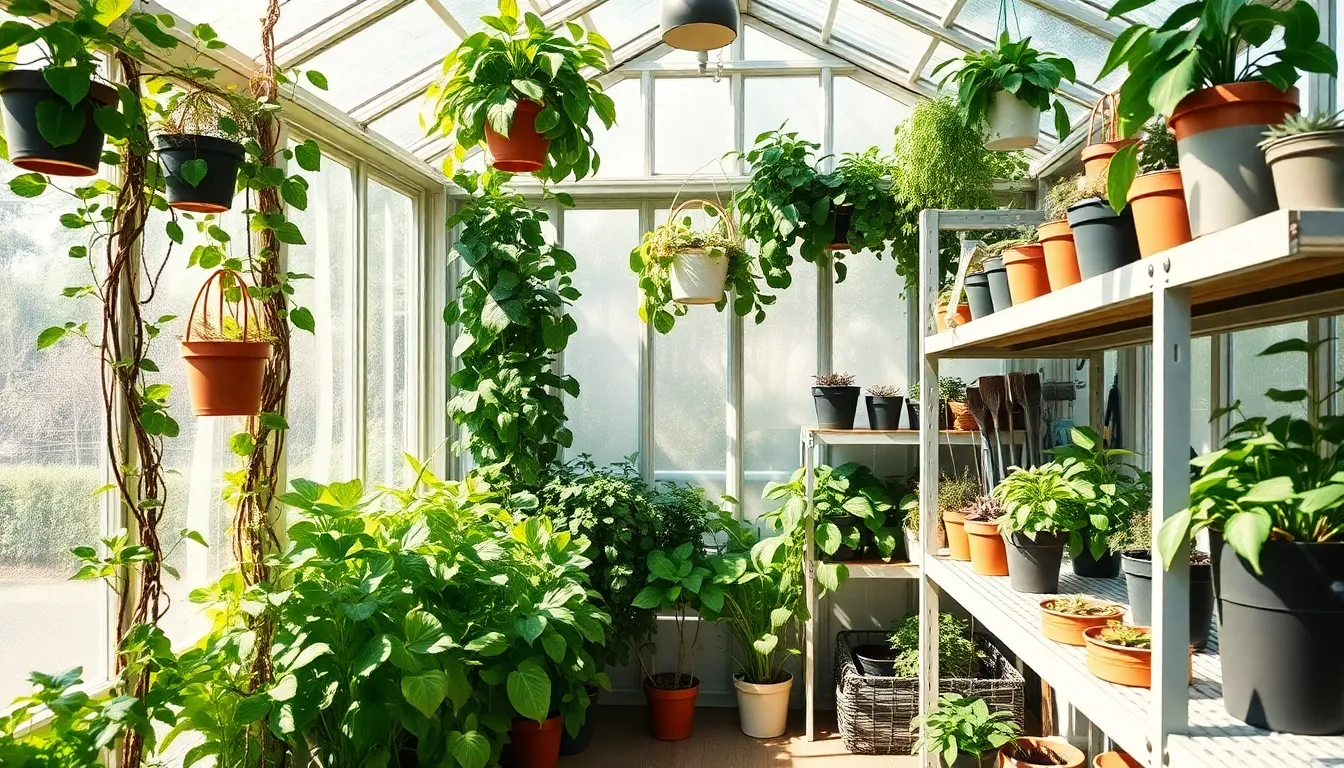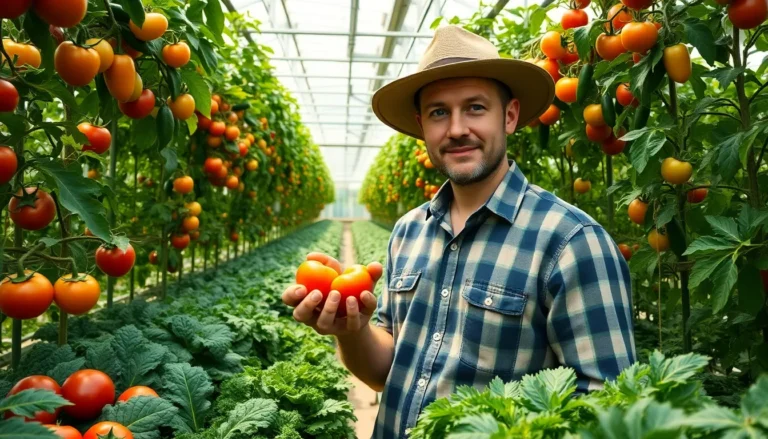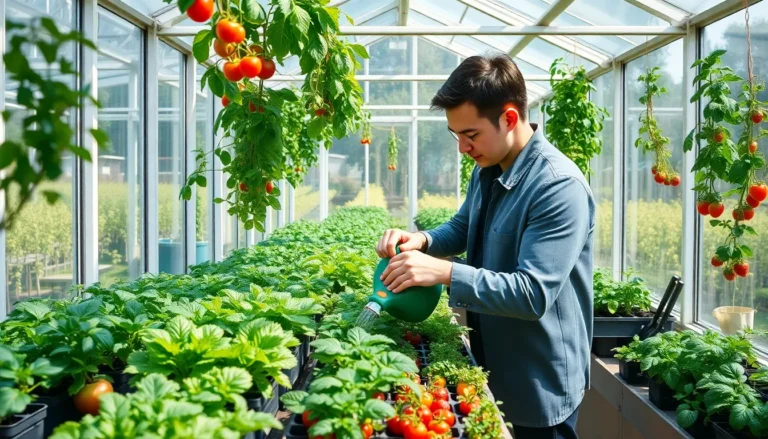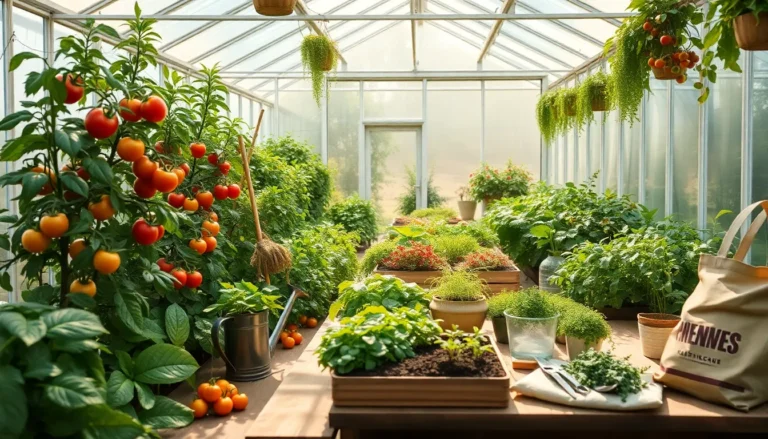Imagine stepping into your very own mini Eden, where fresh herbs and vibrant flowers flourish in a cozy space. Small greenhouses are the perfect solution for those who want to cultivate their green thumb without breaking the bank or sacrificing their backyard. But before diving headfirst into planting, it’s crucial to nail down an effective interior layout that maximizes space and boosts productivity.
From vertical gardens to clever shelving solutions, the right design can turn a cramped greenhouse into a botanical wonderland. Whether you’re a seasoned gardener or just starting out, these small greenhouse interior layout ideas will help you create an inviting and functional space. Get ready to transform your tiny greenhouse into the envy of the neighborhood—who knew growing plants could be this much fun?
Small Greenhouse Interior Layout Ideas
Maximizing space in a small greenhouse requires creative layout strategies. Utilize vertical gardening techniques to free up floor space. Hanging planters and wall-mounted shelves offer efficient storage for pots and tools. Arrange workstations near the entrance for easy access and convenience.
Incorporating tiered shelving can enhance plant visibility while optimizing sunlight exposure. Consider using adjustable shelves to accommodate plants of varying heights. This flexibility supports plant growth and overall aesthetic appeal.
Deploy a rolling cart for easy mobility, making it simple to reposition plants or tools as needed. Employ dedicated zones within the greenhouse, such as potting areas, tool storage, and plant displays. Segregating these spaces promotes organization and efficiency.
Integrate lighting into the layout for improved plant care. LED grow lights can be placed strategically above shelves or work areas to ensure adequate illumination. Sunlight-absorbing panels can also enhance natural light intake.
Incorporate pathways to facilitate movement throughout the greenhouse. Widths of at least two feet yield sufficient space for maneuvering between planters and shelves. Use pavers or stepping stones for easy-to-maintain pathways, enhancing both functionality and aesthetics.
Analyze air circulation and temperature control, placing plants that require similar conditions close to one another. This consideration fosters a supportive environment for plant health.
Lastly, incorporate seating for relaxation or observation. A small bench or chairs allow gardeners to enjoy their space. Implementing these layout ideas can transform a small greenhouse into an efficient, productive, and enjoyable space for cultivating plants.
Maximize Space Efficiency

Maximizing space efficiency in a small greenhouse boosts productivity and enhances the gardening experience. Implementing strategic layout ideas ensures every square foot contributes to plant growth and maintenance.
Vertical Gardening Techniques
Vertical gardening techniques elevate space use by allowing plants to grow upwards. Using wall-mounted planters maximizes vertical real estate while providing plants with optimal sunlight exposure. Climbing plants, such as peas and beans, thrive on trellises, which can be attached to walls or freestanding structures. Hanging baskets also contribute, creating visually appealing layers that save ground space. With careful planning, a small greenhouse can support a diverse range of plants, all while maintaining accessibility and ease of care.
Using Shelving Units
Using shelving units organizes plants efficiently in limited areas. Adjustable shelves provide flexibility for different plant sizes and growth stages, accommodating various gardening needs. Metal or wooden shelving systems create sturdy platforms for pots, ensuring adequate drainage and airflow. Incorporating tiered shelves enhances visibility, allowing for easy access to all plants. Positioning shelves near the greenhouse sides makes ideal use of natural light while freeing up valuable floor space. Dedicated shelving for tools and supplies keeps the greenhouse clutter-free, promoting a more enjoyable gardening environment.
Create Microclimates
Creating microclimates within a small greenhouse enhances plant health and productivity. Understanding environmental needs allows for tailored growing conditions.
Grouping Plants by Temperature Requirements
Grouping plants based on temperature requirements ensures optimal growth. For instance, placing heat-loving plants like tomatoes alongside peppers promotes warmth, while cold-tolerant species such as lettuce thrive in cooler sections. This strategic arrangement minimizes temperature fluctuations and maximizes resource use. It’s beneficial to monitor individual needs, especially during seasonal transitions. Using thermometers in various areas helps adjust layouts as necessary, fostering a stable environment.
Utilizing Different Levels of the Greenhouse
Utilizing different levels in the greenhouse effectively leverages vertical space. Implementing tiered shelving accommodates a variety of plant heights and light preferences. For example, taller plants can occupy the back or higher shelves, while shorter species thrive in front. Hanging pots provide additional levels, cultivating cascading plants that save floor space. Maximizing the vertical area allows for proper air circulation and light distribution, essential for healthy growth. Experimenting with various arrangements inspires creativity and ensures a dynamic growing environment.
Optimize Light Distribution
Optimizing light distribution enhances plant growth in a small greenhouse. Effective placement of plants and use of reflective materials significantly improve sunlight accessibility.
Placement of Plants for Sunlight Access
Arrange tall plants away from shorter ones to prevent shading. Position sun-loving varieties near the greenhouse roof and delicate species closer to the sides. Utilize vertical space by stacking plants on shelves, ensuring lower tiers receive adequate light. Create a rotation system for plants to promote even growth, allowing those needing more light to occupy better-lit spots periodically. Group plants with similar light requirements together to simplify care and maximize light exposure for each species.
Transparent Barriers and Reflective Surfaces
Incorporating transparent barriers enhances light penetration. Use clear glass or polycarbonate panels that allow sunlight to filter through while protecting plants. Install reflective surfaces, such as white panels or aluminum foil, on walls to bounce light deeper into the greenhouse. Strategically place mirrors or reflective materials near plants to increase light availability on cloudy days. Employing these techniques promotes optimal growing conditions, supporting healthy plant development.
Enhance Accessibility
Creating an accessible greenhouse layout allows for smoother operation and better plant care. Prioritizing pathways and container arrangements ensures ease of movement and enjoyment for the gardener.
Pathways and Walkways
Adequate pathways enhance navigation within the greenhouse. Design pathways to be wide enough, ideally 24 inches, for comfortable movement. Use materials like gravel or pavers for durability and stability. Smooth surfaces prevent tripping hazards, promoting safety. Consider a U-shape or loop design to allow access to all areas easily. Ensure that pathways remain free of excess clutter, facilitating quick access to tools and supplies. Maintaining clear routes also aids in effective ventilation, especially with larger greenhouses.
Container Arrangement for Easy Reach
Arranging containers thoughtfully simplifies plant care tasks. Position frequently accessed plants closer to the center or entrance for convenience. Group containers by type, height, or growing requirements for efficient organization. Create tiered arrangements where smaller plants sit below larger ones, promoting light exposure for all. Utilizing rolling carts grants mobility to various plants, making rotation and maintenance easier. Incorporate shelves that adjust to different heights, allowing quick access to all plants without excessive bending or stretching. This setup fosters a productive greenhouse environment while enhancing the gardener’s experience.
Conclusion
Creating an effective interior layout in a small greenhouse can significantly enhance the gardening experience. By implementing innovative design ideas like vertical gardening and strategic shelving, gardeners can maximize space while ensuring optimal plant health.
Incorporating elements such as dedicated workstations and efficient pathways not only improves accessibility but also promotes a clutter-free environment. The thoughtful arrangement of plants based on their needs can lead to thriving microclimates, boosting productivity.
Ultimately, a well-planned small greenhouse becomes more than just a space for plants; it transforms into a personal oasis that nurtures both plants and the gardener’s passion. Embracing these layout strategies will help anyone cultivate a vibrant and productive green space.





